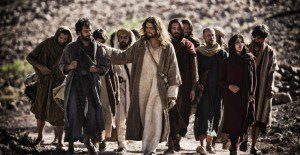 Alas, there was no Transfiguration in this episode. But there was quite a bit of other stuff that I found interesting, for better and for worse, so here again, as before, are my first impressions.
Alas, there was no Transfiguration in this episode. But there was quite a bit of other stuff that I found interesting, for better and for worse, so here again, as before, are my first impressions.
The pacing, redux. It says something about this show that, when it finally devotes an entire two-hour episode to a single protagonist, it still feels kind of rushed, like it’s over far too quickly and we haven’t had a chance to really get to know anyone.
The protagonist in question, of course, is Jesus, and the series actually started his story last week, with his birth and baptism, and will finish it next week, with his death and resurrection. What’s interesting about the structure of these Jesus episodes is the way they basically seem to devote half their running time to the events of Holy Week — i.e. the period between Jesus’ arrival in Jerusalem on Palm Sunday and his resurrection from the tomb one week later — as well as, possibly, the resurrection appearances that occurred afterwards. In this, the series is not unlike John’s gospel, which devotes 10 of its 21 chapters to this narrow period of time. (By comparison, the Holy Week part of the story takes up maybe about a third of Matthew and Mark’s gospels, and only about a fourth or even a fifth of Luke’s gospel.)
In fact, when you consider that the mini-series spent only 14 minutes on the adult Jesus last week (after spending half an hour on his birth and youth, periods that are completely ignored by the gospels of Mark and John), and that the entire 9th hour of the series goes by the name ‘Passion’, there is a distinct possibility that the series might end up devoting almost two thirds of its Jesus time to the events following Palm Sunday — which may be unprecedented for a film that isn’t meant to be exclusively about the events of Holy Week a la The Passion of the Christ (2004).
New juxtapositions. One of the more fascinating things about this episode is the way it brings different elements from the gospels together in new and intriguing ways.
Take, for example, the way Nicodemus effectively “betrays” Caiaphas just as Judas betrays Jesus. Nicodemus starts out as one of the Jewish leaders who is deeply concerned about Jesus — indeed, it is he who first passes on a Pharisee’s report about Jesus, a report that is initially laughed off by Caiaphas — but, by the end of the episode, he has turned around and come over to Jesus’ side. And the scenes in which Nicodemus’s transformation occur are cross-cut with the scenes in which Caiaphas persuades Judas to betray Jesus.
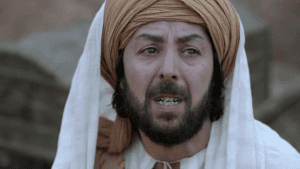 Then there is the scene where Jesus calls on Matthew, the tax collector, to join him and his disciples. When the scene begins, Jesus is surrounded by disciples who follow him and at least one Pharisee who criticizes him — but the one thing disciples and Pharisee can agree on is that tax collectors are “vermin”. Jesus responds by telling the parable of the publican and the Pharisee — and as he reaches the words that the publican spoke in humble prayer, Matthew recites them in sync with Jesus and starts to cry.
Then there is the scene where Jesus calls on Matthew, the tax collector, to join him and his disciples. When the scene begins, Jesus is surrounded by disciples who follow him and at least one Pharisee who criticizes him — but the one thing disciples and Pharisee can agree on is that tax collectors are “vermin”. Jesus responds by telling the parable of the publican and the Pharisee — and as he reaches the words that the publican spoke in humble prayer, Matthew recites them in sync with Jesus and starts to cry.
It’s an especially powerful moment, and it may catch the viewer by surprise, inasmuch as it suggests that Jesus is not only telling a story here but exercising his divine or prophetic knowledge of something that Matthew had done more-or-less in private. And of course, by exercising his knowledge like this, Jesus lets Matthew know that his prayers have been heard, which gives Matthew an emotionally compelling reason to drop his work and join the Jesus movement right then and there. (Honestly, I get a little verklempt just thinking about that scene as I write these words, three days after seeing it.)
The Matthew scene is also intriguing to me because, in at least some versions of the Eastern Orthodox sacrament of confession, the priest asks God to forgive the person who has just given his confession by appealing to the way God forgave various other people in the Bible — including the publican! But the publican was fictitious, part of a story within the story, even on the Bible’s terms, right? This is one of the points that has come up when my fellow Orthodox and I discuss the sometimes murky relationship between history and fiction in our tradition — but for what it’s worth, I have never had a problem with this particular prayer, because clearly the parable presents the publican as a “type” of sinner that God does, in fact, forgive.
So, on the whole, I think it’s actually quite brilliant that the mini-series goes one step further and ties this parable to an actual person.
That being said, I cannot help but also contrast the Matthew-and-parable scene here with a very different Matthew-and-parable scene in another movie. In Franco Zeffirelli’s Jesus of Nazareth (1977), Matthew is Peter’s neighbourhood tax collector, and Peter hates him for obvious reasons — so when Jesus goes to Matthew’s house, he bridges the gap between these two men by telling the parable of the prodigal son. When Peter hears the words of the father to the jealous elder brother, Peter realizes that he is committing the same sin as the elder brother, and this realization leads to a reconciliation with Matthew which is quite powerful in its own way.
In The Bible, on the other hand, Jesus tells the parable of the publican and the Pharisee in the presence of an actual Pharisee who is already very critical of Jesus’ movement. And as Matthew goes on to join Jesus’ movement, the Pharisee proclaims that if Jesus is accepting sinners like Matthew, then who knows what other kinds of sinners there might be in Jesus’ entourage. So where, in Zeffirelli’s film, the parable served to bring together two former enemies, the current mini-series is, perhaps, more divisive, more conducive to us-vs.-them ways of thinking.
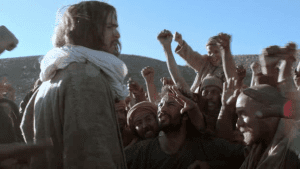 Nationalism, inverted. I mentioned two weeks ago that the mini-series seemed to be pandering to a certain kind of nationalism, in scenes like the one where Israelites under Joshua chant “Israel! Israel! Israel!” after conquering Jericho. But this Jesus-themed episode flips that motif on its head.
Nationalism, inverted. I mentioned two weeks ago that the mini-series seemed to be pandering to a certain kind of nationalism, in scenes like the one where Israelites under Joshua chant “Israel! Israel! Israel!” after conquering Jericho. But this Jesus-themed episode flips that motif on its head.
First, after Jesus miraculously feeds the multitude — which is the only miracle that appears in all four gospels, incidentally (and in two of them, it even happens twice) — the crowd of five thousand expresses a desire to make Jesus their king, and they all start chanting “Israel! Israel! Israel!” This bothers Jesus, who says, “No, this is not the way! Not by force!”
Later, when Jesus is asked if the Jews should pay taxes to Caesar, the crowd immediately chants “No!” and, again, “Israel! Israel! Israel!” And Jesus, of course, gives the same brilliant answer to this question that he gives in the gospels, and goes even further by tossing the coin to a nearby Roman soldier.
So there’s a very explicit link between the Joshua and Jesus episodes, thanks to the chanting — and the link is made even more interesting when you realize that Joshua and Jesus are basically the same name. (Joshua = Yehoshua = Yeshua = Jesus.)
But does the mini-series encourage us to think about the connection? Does it have anything to say about Joshua’s explicitly violent campaign of conquest and Jesus’ equally explicit rejection of violence? Does it offer any explanation for the apparent change in divine tactics between these two episodes? If so, I can’t figure out what it is.
Still, it’s interesting that the filmmakers put the chant in both episodes. It’s only natural to assume they meant something by it.
The violence, redux. It wouldn’t be a Bible episode without a little gratuitous violence, so this one gives us at least two, courtesy of Pilate.
In one, he’s practising sword-fighting at his residence — and, after he has clearly defeated his fighting partner, he gashes the man’s chest for no good reason.
And in the other, Pilate unleashes his soldiers on a crowd of Jews who have gathered to protest the use of Temple funds for building an aqueduct.
Neither of these episodes are biblical, per se; the aqueduct episode, in fact, comes from Josephus. But Luke 13 does tell us about some Galileans who were slaughtered by Pilate — which, I believe, is the only reference in the New Testament to any of Pilate’s actions outside of Holy Week — so there is, admittedly, some basis in the Bible for depicting Pilate’s cruelty outside of his interactions with Jesus.
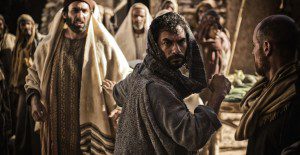 Turning the other cheek. “Show, don’t tell,” the saying goes, and a number of Jesus films, instead of simply letting Jesus recite the command to turn the other cheek, have tried to actually show people doing this in response to Jesus’ command.
Turning the other cheek. “Show, don’t tell,” the saying goes, and a number of Jesus films, instead of simply letting Jesus recite the command to turn the other cheek, have tried to actually show people doing this in response to Jesus’ command.
The CBS mini-series Jesus (1999), for example, had Jesus himself turn the other cheek after the Jewish zealot Barabbas strikes him, and the musical Godspell (1973), set in the modern era, had Jesus himself slap one of his followers’ cheeks, as punishment for blasphemy, after which the follower in question reins in his own impulse to strike back.
The Bible puts a slightly different spin on this by having Jesus give the instruction to Peter after some of their Jewish opponents start throwing stones at them.
It was all a big misunderstanding! As New Testament scholar Mark Goodacre, one of this series’ consultants, notes, one of the biggest challenges facing anyone who would dramatize the death of Jesus is how to portray his Jewish opponents, chief of whom was the high priest Caiaphas.
The Bible does a decent job of making Caiaphas a recognizably human person, with justifiable concerns about the future of his people and an alarming willingness to sacrifice “one peasant” for the sake of the nation. But the mini-series also suggests that Caiaphas prosecuted Jesus on the basis of a rumour that got out of control — and its portrayal of the incident that sparked this rumour is just kind of goofy, if you ask me.
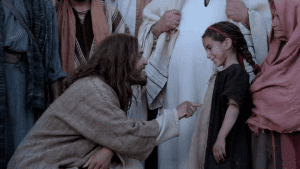 Specifically, as Jesus leaves the Temple, he smiles at a little girl and pokes her and tells her that “not one stone of this place — not one stone! — will be left standing.” This is quickly interpreted by Jesus’ enemies, including Caiaphas, as an indication that Jesus plans to destroy the Temple himself — and thus, the mini-series seems to be suggesting that the death of Jesus was just the result of a big misunderstanding. A big, big, big misunderstanding.
Specifically, as Jesus leaves the Temple, he smiles at a little girl and pokes her and tells her that “not one stone of this place — not one stone! — will be left standing.” This is quickly interpreted by Jesus’ enemies, including Caiaphas, as an indication that Jesus plans to destroy the Temple himself — and thus, the mini-series seems to be suggesting that the death of Jesus was just the result of a big misunderstanding. A big, big, big misunderstanding.
But what is the proper understanding of what Jesus said? Why, in fact, did Jesus say it? In the mini-series, it kind of comes out of nowhere. But in the gospels, Jesus says it in response to disciples of his who had started to praise the building they were standing in. When Jesus said “not one stone” would be left standing, he was predicting the building’s ultimate destruction at the hand of the Romans — which hardly seems like a fit subject for playful banter with a young child.
Indeed, according to Luke 23, when Jesus was being led to his death, he told the women of Jerusalem not to weep for him but to “weep for yourselves and for your children. For the time will come when you will say, ‘Blessed are the childless women, the wombs that never bore and the breasts that never nursed!'” That is the one time in the Bible that Jesus referred to children when predicting the fall of Jerusalem, and he was anything but smiley about it.
What is Jesus thinking, redux. Last week, I noted how the mini-series used flash-forwards and at least one point-of-view shot to allow us to identify, however partially, with Jesus’ subjectivity and thus with his humanity.
This episode continues the pattern. When Jesus hears of the death of John the Baptist, he is clearly bothered, and as he mulls it over, we get a flashback to that same point-of-view shot, of John’s face hovering over Jesus during the latter’s baptism. And we get some more flash-forwards to Jesus’ death, particularly at the Last Supper.
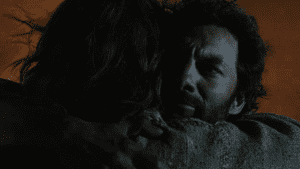 It’s noteworthy, too, how Jesus hugs Peter rather tightly — it’s a loving hug — when Peter says he will never desert Jesus. And it is while Jesus is hugging Peter that Jesus predicts Peter will deny him three times. It is as though Jesus wanted to reassure Peter of his love for him even as he made a prediction that, in some ways, could have come across as a rebuke.
It’s noteworthy, too, how Jesus hugs Peter rather tightly — it’s a loving hug — when Peter says he will never desert Jesus. And it is while Jesus is hugging Peter that Jesus predicts Peter will deny him three times. It is as though Jesus wanted to reassure Peter of his love for him even as he made a prediction that, in some ways, could have come across as a rebuke.
Finally, I like the way Jesus and Malchus look at each other after Jesus heals Malchus’s ear. That brief moment of eye contact between Jesus and Malchus — before the bag goes over Jesus’ head and Malchus’s fellow temple guards take him away — almost feels like a set-up for some continued character development on Malchus’s part in the next episode, but, at the pace this series goes, I wouldn’t count on it. Ah well.
Re-assigned dialogue. I have already noted how the mini-series gives Nicodemus, at least, a sort of character arc, inasmuch as he starts out as one of the Jewish leaders who is deeply skeptical of Jesus, and then gradually comes around to believing in him, or at least to giving him the benefit of the doubt.
Thus, it is Nicodemus, and not some anonymous nobody, who confronts Jesus with the question re: paying taxes to Caesar. And it is Nicodemus who Jesus addresses as “hypocrite” in one of the earlier scenes, when Jesus turns over the moneychangers’ tables.
Other bits of dialogue are re-assigned in interesting ways, too. It is one of the disciples, not Jesus, who tells the other disciples that Jesus came to save sinners, not the righteous. And it is Peter who, cautiously, first warns Jesus that claiming the power to forgive sins is a form of “blasphemy”; Peter makes this remark in the presence of a Pharisee who is in the middle of confronting Jesus, and the Pharisee basically picks up on this and says, “See? He knows.”
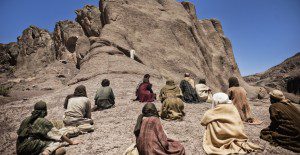 Finally, I liked the way the Sermon on the Mount — and the Lord’s Prayer in particular — is spread out over a montage in which we see Jesus teach his followers in multiple locations. Most scholars agree that the Sermon on the Mount, as recorded in the Bible, is a literary device that gathers many of Jesus’ sayings, rather than a historical record of an actual sermon in which Jesus stood in one place and recited a bunch of things all at once. Pier Paolo Pasolini captured this aspect of the Sermon quite brilliantly in The Gospel according to St. Matthew (1964) by filming each of the sayings separately and editing them together in a montage; here, the mini-series does something similar, though a little different, by having a single teaching spread out over multiple clips. It still conveys the basic idea, though, that Jesus’ sayings would have been spoken multiple times, in multiple ways, before they sank into everyone’s minds.
Finally, I liked the way the Sermon on the Mount — and the Lord’s Prayer in particular — is spread out over a montage in which we see Jesus teach his followers in multiple locations. Most scholars agree that the Sermon on the Mount, as recorded in the Bible, is a literary device that gathers many of Jesus’ sayings, rather than a historical record of an actual sermon in which Jesus stood in one place and recited a bunch of things all at once. Pier Paolo Pasolini captured this aspect of the Sermon quite brilliantly in The Gospel according to St. Matthew (1964) by filming each of the sayings separately and editing them together in a montage; here, the mini-series does something similar, though a little different, by having a single teaching spread out over multiple clips. It still conveys the basic idea, though, that Jesus’ sayings would have been spoken multiple times, in multiple ways, before they sank into everyone’s minds.
Watered down? Some of Jesus’ key sayings are trimmed a little much for my liking. For example, the mini-series shows him saying, “I am the way, the truth and the life,” but not, “No one comes to the Father except through me.” Or it shows him at the Last Supper saying, “This is my body,” and, “This is my blood,” but not the verses that follow, about his body being broken for us or his blood being shed for the remission of our sins.
But that might just be quibbling on my part. The mini-series does have Jesus saying things like, “You only have one Father, and he is in Heaven; you only have one teacher, and he is the Christ,” so it’s not like the film downplays the Christology, per se. Chalk this up, perhaps, to the many cuts, big and small, that had to be made to fit the mini-series’ running time.
 Odds and ends. Satan makes another brief appearance in this episode, as Judas leaves the Last Supper and coughs up the bread that Jesus gave him. This is an interesting way of communicating, visually, that God has left Judas (inasmuch as the bread can be understood on a sacramental level) while Satan, to quote Luke 22, “entered Judas”.
Odds and ends. Satan makes another brief appearance in this episode, as Judas leaves the Last Supper and coughs up the bread that Jesus gave him. This is an interesting way of communicating, visually, that God has left Judas (inasmuch as the bread can be understood on a sacramental level) while Satan, to quote Luke 22, “entered Judas”.
Question: How did Jesus go from having just one follower — Peter — at the end of the last episode to having a big crowd follow him at the beginning of this one?
This is at least the third film — following Martin Scorsese’s The Last Temptation of Christ (1988) and the Visual Bible’s The Gospel of John (2003) — to place at least one female disciple (Mary Magdalene, natch) at the Last Supper and/or Gethsemane.
It’s also striking how Jesus’ prayer in Gethsemane is cross-cut with the prayers of the Jewish leaders and the prayers of Pilate and his wife to their ancestors. Could this be setting up something for the next episode, too? We shall see.












